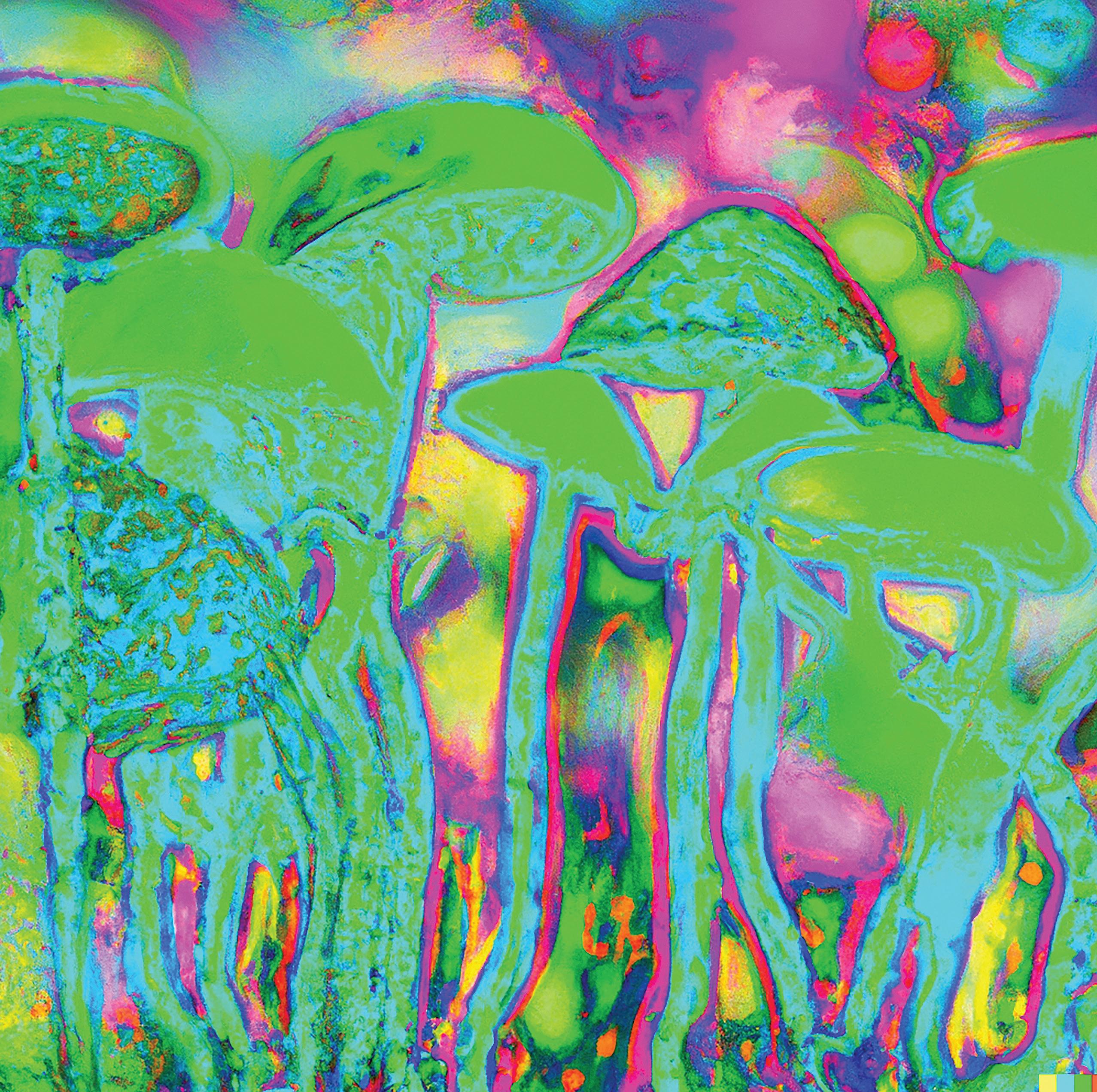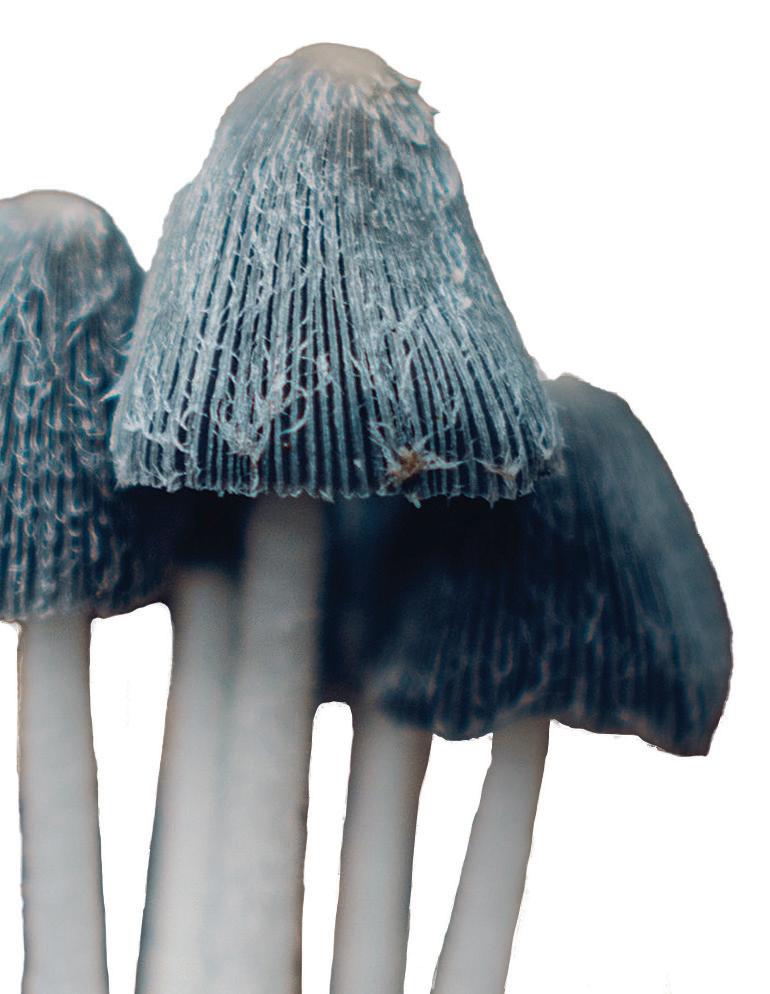Healing Journeys
“THERE IS A DIFFERENCE between seeing and perceiving. Seeing is recognizing and perceiving is knowing. Perceiving is the same as receiving and it is the same as responding.”—Agnes Martin, painter Inspiration can be elusive, even for an artist. When psilocybin, the psychedelic compound found in magic mushrooms, was legalized in Colorado last year, it piqued the interest of many artists who hoped to bolster creativity and view the world through new eyes.
This February, two Steamboat Springs artists shared a psilocybin experience to learn how the drug affects creativity and mental

health. The artists, who we will call Emily and Sophia for the sake of anonymity, shared the details of their journey.
“We were both very nervous, but once we started that all just melted away,” Emily recalls. The artists began the journey indoors but were quickly drawn outside. “The whole world opened up as if I were a child again,” Emily says. “Every small detail was filled with wonder – watching a fly walk on the snow, the shifting of the clouds, leaves dancing in the wind.”
Both artists reported an increased interest in the minute details of the world around them. “Somehow the mushrooms took me out of my busy mind and let me just watch the world go by,” Emily says. “I was content to disappear into each moment without trying to control it. I became curious about the world again. The light and the shadows, the way the aspens light as the sun starts to set. My mind was engaged in the world before me, instead of lost in thoughts.”
“I experienced reflective thought and wonder,” Sophia says. “I was more open to my perceptions, less filtered. It was refreshing.”
Emily and Sophia entered the experience with curiosity about how it would impact their creative processes. Ultimately, they found that psilocybin fosters an “openness” that has the potential to be harnessed creatively. “It enhances the details of things,” Emily says. “A patch of sunlight hitting the root of a tree became an experience in itself. I wouldn’t normally take the time to just sit outside and look around..”
“We see things all the time, but perceiving is knowing,” Sophia says. “Perceiving is where the magic happens, where an artist brings something new to the table. I think we turn to things that alter our state of consciousness in the hope of jostling ourselves out of just seeing and into perceiving.”
However, the artists reported that this openness can be difficult to harness into active creativity. “On mushrooms I had that buzz and spark of untethered inspiration, but there was no way I could ground that to make art,” Sophia says. “I was too distracted to really get anything done. I had trouble filtering my perceptions.”
Photo courtesy of Dagny McKinley
OUT THERE
“In that moment, you’re not in a mental state to make art,” Emily adds. “Or at least, I wasn’t.”
While psilocybin carries potential in terms of creative growth, therapeutic possibilities exist as well. A physician, who we’ll refer to as Dr. Pete to preserve anonymity, expressed optimism about psilocybin’s medical applications. “It’s exciting to see that a couple of therapy sessions with psilocybin can still result in benefits six months later,” he says. “The early research is showing that psilocybin has tremendous benefits for treating anxiety and depression, and that two sessions can be equivalent to six months of selective serotonin reuptake inhibitors (SSRIs).” Dr. Pete added that testing is taking place to see if psilocybin helps with post-traumatic stress disorder (PTSD). If benefits are proven in that regard, the drug’s therapeutic use will likely become significantly more widespread.
Psilocybin’s legalization in Colorado allows its use in conjunction with psychotherapy. “It tends to make the patient far more open and create less blocks to working through mental health issues,” Dr. Pete explains. He attributes this to a combination of increased neuroplasticity (the ability of neural networks in the brain to change and reorganize) and increased openness. “There are tremendous benefits,” Dr. Pete says. “This type of therapy allows you to rethink what has happened to you and how you handle things.”
Dr. Pete is among those who have personally experienced the benefits of psilocybin use, though he was hesitant to try it at first.
“It took two friends of mine a year and a half to get me to try it,” he chuckles. “I’ve always been very anti-drug, but I tried several of these sessions and found them to be amazing. I was shocked by all the trauma that poured out of me. I felt all these things I didn’t expect to feel, and came away from it feeling much better.”
As a medical professional, Dr. Pete has witnessed first-hand psilocybin’s rising popularity in the medical community. “I think there’s more understanding of mental health issues now, and acceptance of our own mental health issues,” he says. “There’s more of an understanding that we all have degrees of these issues and can all be better. Ninety-nine
percent of the patients I talk to are interested in it, and I recommend it to everyone.”
Emily and Sophia also weighed in on their experience’s potential mental health applications. “It brought me back to the center of joy that I can sometimes tap into, but I tend to push aside,” Emily says.
“It alters your perceptions,” Sophia says. “If you’re locked into seeing things a certain way, you can see things differently. If you’ve been living in Steamboat through 100 days of dark, cold winter, you can break out of some thought patterns you might be in.”
When trying psilocybin for the first time, it’s important to prepare appropriately for the experience. “Everyone is nervous about things they don’t know,” Dr. Pete says, “so it’s important to have a physician walk you through the experience, educate you, tell you everything you need to know.” Titration – starting with a small dose, then gradually increasing until you reach an appropriate and comfortable level—is also key to having a positive experience, Dr. Pete says.
Emily and Sophia have several key pieces of advice for fledgling psilocybin users. “Prepare by having a safe space,” Emily says. “A place where everything is familiar and you have some control. I would not suggest being out in public unless you have someone completely sober with you. Remember it’s a limited amount of time, 5-6 hours. Make sure you don’t have much going on the next day, since you might be exhausted. Make sure you’re in a good mental place beforehand. You are about to take an emotional journey which could be very painful.”
“Take it from a trusted source, and really have a handle on dosing,” Sophia adds. “If you’re an artist and you want to try creating during your experience, make sure to prepare the materials beforehand.”
In the coming years, we will undoubtedly gain a clearer understanding of psilocybin. But only time will tell if this will help us gain a clearer understanding of the world – and of ourselves.

Disclaimer: While psilocybin has been legalized in Colorado, guided psilocybin therapy is not yet widely available and many legal restrictions still apply to psilocybin use. Research the laws and restrictions in detail before pursuing psilocybin use.
ELEVATE THE ARTS: Find new inspiration to create art. Try a different color palette or create in a space you have never created before like in the middle of the woods, or in a bowling alley. DG
84
Art with Altitude
Photo courtesy of Alonso Romero




